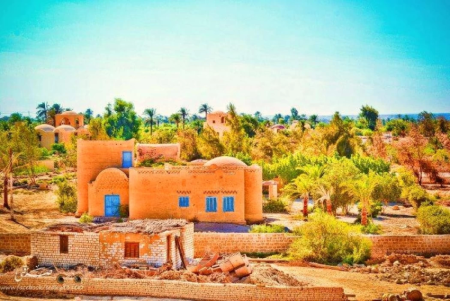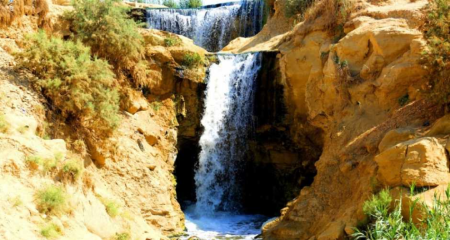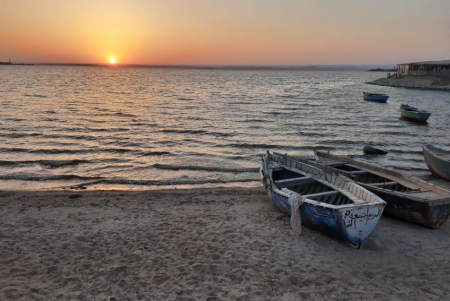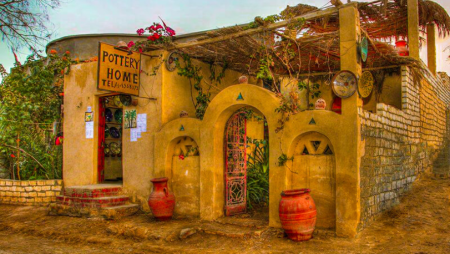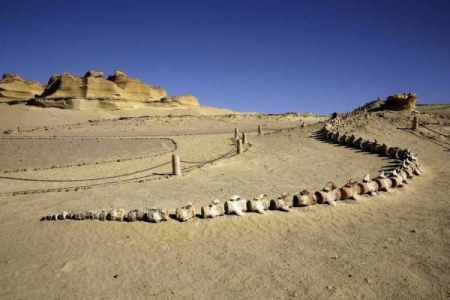wadi al hitan

Wadi Al Hitan: The Valley of Whales – Egypt’s Window into Prehistoric Oceans
Tucked within the wind-carved dunes of Egypt’s Western Desert, Wadi Al Hitan—known as the Valley of Whales—stands as one of the planet’s most remarkable paleontological treasures. This UNESCO World Heritage Site lies deep in the Fayoum City depression, roughly 150 kilometers southwest of Cairo. The site’s hauntingly beautiful desert landscape holds fossilized skeletons of ancient whales that swam in Earth’s primordial seas some 40 million years ago. For scientists and adventurers alike, Wadi Al Hitan isn’t just a dusty fossil bed; it’s a vivid, open-air museum chronicling one of the most critical evolutionary transitions—the shift from land-dwelling mammals to ocean-dominant whales.
The story of this valley is as mesmerizing as its name implies. Once submerged beneath the Tethys Sea, the region gradually transformed into dry desert terrain over millions of years. The fossils discovered here, including those of *Basilosaurus* and *Dorudon*, reveal the evolutionary secrets of marine life adapting from terrestrial habitats to aquatic dominance. Visitors walking amid these colossal relics can almost hear echoes of ancient waves crashing against prehistoric shores. It’s no wonder that Wadi Al Hitan has captured the imagination of travelers seeking more than the typical Egypt itinerary of the Great Pyramids of Giza or the splendor of Luxor City.
Beyond its scientific significance, this desert sanctuary entices eco-tourists, photographers, and geology enthusiasts. Its surreal sandstone formations, fossil beds, and silence under the stars create a tranquil yet mysterious allure. Blending discovery with conservation, Wadi Al Hitan has become a beacon for sustainable tourism in Egypt, pairing ancient knowledge with modern ecological stewardship. Whether you’re chasing adventure, history, or the whisper of deep time, the Valley of Whales offers an unforgettable encounter with Earth’s living memory.
The Geological Marvel of Wadi Al Hitan: How Time Shaped a Prehistoric Sea
Millions of years ago, the area that now holds Wadi Al Hitan was submerged under the vast Tethys Ocean. Over epochs, tectonic shifts and receding seas gave rise to Egypt’s Western Desert, leaving behind layers of sediment rich with marine fossils. The valley’s golden cliffs and dunes, sculpted by wind erosion, showcase distinct geological strata revealing the Earth’s dynamic past. Sandstone and limestone formations cradle hundreds of vertebrate fossils, shells, and coral remnants, making this UNESCO site a vital chapter in planetary history.
When exploring the region, you’ll notice the terrain’s transition—flat desert plains punctuated by smooth escarpments shaped by ancient water currents. This natural artistry speaks volumes about how climate and geography intertwined to create a fossil repository unmatched anywhere else. Adventurers often combine visits here with Wadi El Rayan, known for its waterfalls and lakes, offering a unique chance to witness contrasting landscapes born of the same geological evolution.
Wadi Al Hitan Fossils: The Evolutionary Tale of Ancient Whales
The fossils at Wadi Al Hitan tell a captivating evolutionary story. Discovered in the early 20th century by Western explorers, these skeletons belong to early forms of whales from the Eocene epoch. Unlike modern whales, these creatures possessed hind limbs, indicating a transitional stage between land mammals and fully aquatic whales. The centerpiece species, *Basilosaurus isis*, stretches over 18 meters long, its elongated serpentine body suggesting adaptations for swimming yet showing traces of terrestrial ancestry.
Equally fascinating is *Dorudon atrox*, a smaller whale species that likely coexisted with the formidable *Basilosaurus*. Remains of fish, turtles, and sharks found alongside these fossils provide further insight into the prehistoric ecosystem. Paleontologists use these discoveries to piece together how mammals evolved breathing systems, skeletal structures, and hunting methods suited for aquatic life. The fossil evidence here bridges a crucial evolutionary gap, enriching global understanding of life’s adaptability.
Experiencing Wadi Al Hitan: A Journey Through Time and Silence
Visiting Wadi Al Hitan feels like stepping into an ancient world frozen in amber. The valley’s serenity, broken only by a whispering desert breeze, invokes awe and introspection. Modern facilities such as the Fossil and Climate Change Museum blend seamlessly into the terrain, offering interactive exhibits that narrate both geological and biological evolution. Open-air trails lead visitors through clearly marked fossil sites, ensuring scientific preservation while providing an accessible educational experience.
For those craving exploration, guided eco-tour options are available through specialized Egypt Desert Tours. These immersive excursions combine adventure with learning, often including overnight desert camping beneath a canopy of stars. The absence of artificial light makes stargazing here nothing short of magical, adding yet another layer of wonder to this prehistoric haven.
Sustainable Tourism and Conservation Efforts at Wadi Al Hitan
As global awareness of environmental preservation grows, Wadi Al Hitan stands as a model of responsible tourism. The Egyptian Environmental Affairs Agency, alongside UNESCO, ensures that visitor activities align with strict conservation standards. Eco-friendly initiatives focus on limiting vehicular access, maintaining fossil integrity, and promoting guided tours to manage foot traffic. Local Bedouin communities also play a role, offering authentic cultural experiences that benefit the region’s economy while safeguarding its natural heritage.
Travelers who prioritize sustainability can pair their visit with eco tours in Egypt or longer itineraries that include other protected areas such as The White Desert of Egypt. This integration between cultural immersion and environmental education exemplifies a new wave of responsible travel across the country.
How to Get to Wadi Al Hitan and Best Time to Visit
Reaching Wadi Al Hitan is part of the adventure. Most travelers begin their journey in Cairo city before heading southwest toward the Fayoum Oasis. From there, a four-wheel-drive vehicle navigates off-road tracks through dramatic desert scenery until the valley emerges in view. The travel distance may seem daunting, but the reward is incomparable—few places on Earth so vividly connect the present to the prehistoric past.
The best time to visit falls between October and April when temperatures are cooler and skies are crystal clear. During these months, visitors can comfortably explore fossil trails and enjoy extended camping experiences. Photographers will find golden hours particularly enchanting as sunlight dances across sand formations, accentuating their natural hues. Pairing a visit to Wadi Al Hitan with a serene afternoon at Qarun Lake rounds out a perfect Fayoum adventure.
Wadi Al Hitan Museum: Merging Science, Education, and Heritage
The Fossil and Climate Change Museum at Wadi Al Hitan is Egypt’s first eco-museum dedicated to paleontology and environmental awareness. Constructed from locally sourced materials, the building harmonizes with the desert’s aesthetic while minimizing ecological impact. Inside, exhibitions display authentic whale skeletons, ancient shells, and interpretative panels illustrating how climate influenced Egypt’s evolution from ocean to desert. The museum emphasizes the link between ancient climate change and current environmental challenges, reminding visitors of Earth’s resilience—and fragility.
Interactive programs allow visitors to understand fossil excavation techniques, geological mapping, and the fascinating process of reconstructing ancient ecosystems. This educational initiative not only attracts scientists and students but also families eager to experience hands-on learning. It represents a forward-thinking approach that balances tourism, education, and preservation.
Adventure Activities Near Wadi Al Hitan: Beyond Fossils
While the fossils are the valley’s crown jewel, the surrounding region offers a wealth of exciting experiences. Nearby attractions include the picturesque Fayoum Oasis with its lush farmlands and pottery villages, and the tranquil dunes of The Crystal Mountain. Adventurers can enjoy sandboarding, camel rides, or desert safaris—perfect complements to the scientific intrigue of Wadi Al Hitan. These unique landscapes highlight Egypt’s diversity beyond its ancient temples and monuments.
For those who prefer a mix of relaxation and cultural immersion, exploring Fayoum’s Tunis Village is a must. Known for its artistic pottery and serene atmosphere, this creative hub showcases the symbiotic relationship between nature, craftsmanship, and community. The combination of geological discovery and cultural authenticity makes Wadi Al Hitan a cornerstone of Egypt’s growing eco-tourism map.
Frequently Asked Questions about Wadi Al Hitan
1. Why is Wadi Al Hitan called the Valley of Whales?
The name ‘Wadi Al Hitan’ translates to ‘Valley of Whales’ because it contains hundreds of fossilized whale skeletons dating back about 40 million years. These fossils, including ancient species such as *Basilosaurus* and *Dorudon*, reveal the evolutionary journey of whales from land mammals to fully aquatic creatures.
2. Where is Wadi Al Hitan located?
Wadi Al Hitan is situated in Egypt’s Western Desert within the Fayoum Depression, about 150 kilometers southwest of Cairo. The site lies near the protected area of Wadi El Rayan, known for its lakes and waterfalls.
3. What makes Wadi Al Hitan a UNESCO World Heritage Site?
It earned UNESCO World Heritage status in 2005 due to its exceptional fossil record that documents a critical stage in whale evolution. The site’s pristine preservation and scientific importance make it invaluable for understanding life’s adaptation from land to sea.
4. How can visitors explore Wadi Al Hitan responsibly?
Visitors should follow marked trails, avoid touching fossils, and book guided tours through responsible agencies offering Egypt Vacations Packages that emphasize sustainability. Bringing minimal waste, respecting local guidelines, and supporting eco-friendly accommodations help preserve the valley’s fragile ecosystem.
5. What nearby attractions complement a trip to Wadi Al Hitan?
Notable nearby spots include Qarun Lake, Fayoum Oasis, and The White Desert of Egypt. Each location offers unique natural beauty and outdoor activities, making them perfect additions to any desert adventure itinerary.


